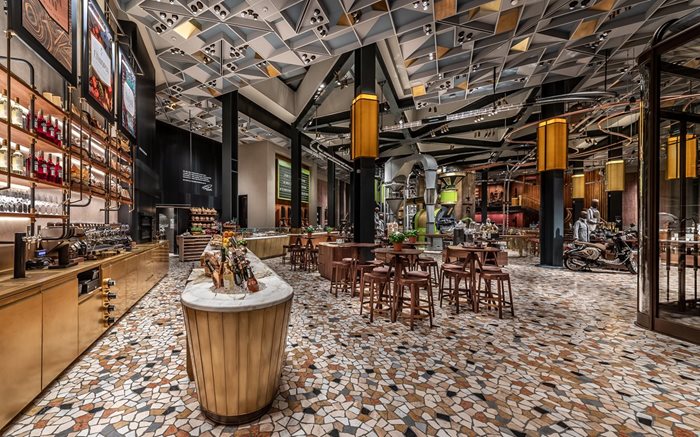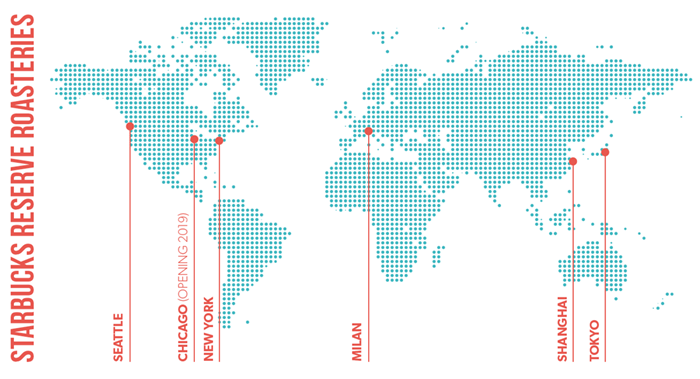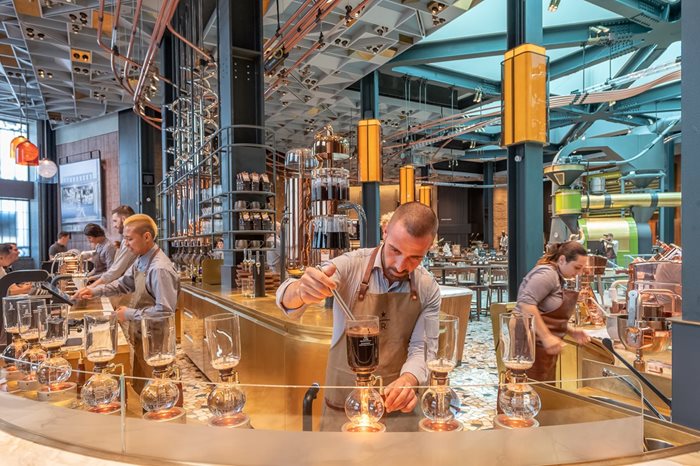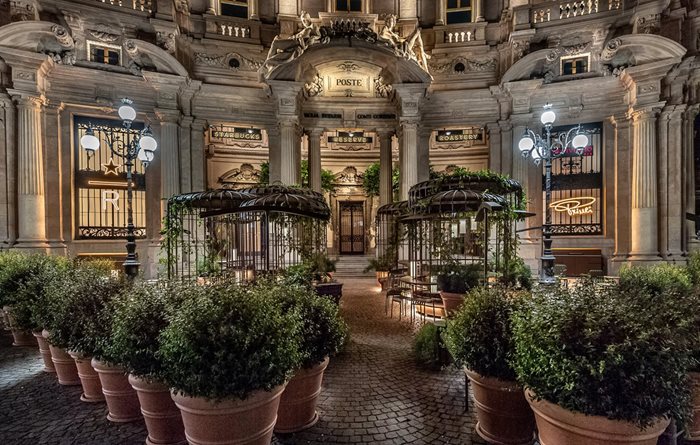World Coffee Portal speaks to Martin Brok about his brand’s long-awaited Italian debut and why the Milan Reserve Roastery is the US coffee chain’s most significant project to date
 Palladiana mosaic flooring and Tuscan marble counters pay homage to Milan’s cultural heritage. Photo credit: Starbucks / Matthew Glac
Palladiana mosaic flooring and Tuscan marble counters pay homage to Milan’s cultural heritage. Photo credit: Starbucks / Matthew Glac
Wherever a Starbucks Reserve Roastery opens, the excitement is palpable. Across Seattle, Shanghai, Milan, New York and Tokyo, Starbucks premium hospitality concept has opened to fanfare more akin to blockbuster premier than coffee shop debut.
But the popularity of the Reserve brand isn’t just clever marketing, it’s the culmination of Starbucks’ 48-year journey to encourage generations of coffee consumers to become coffee connoisseurs.
Today, branded coffee shop innovation is increasingly defined by a burgeoning crop of scaled boutique operators. But with its breath-taking roastery, sumptuous espresso bar, Arriviamo cocktail lounge and premium Princi bakery – all housed in a dramatic 19th Century neo-classical building – perhaps none manifests the 5th Wave era more succinctly than Starbucks’ Milan Reserve Roastery.
The Italian Connection
Celebrated by the Seattle-based chain as the ‘most beautiful’ of is 30,000 stores globally, this veritable cathedral of coffee is hugely symbolic for Starbucks’ contemporary brand narrative. Milanese caffè culture famously inspired former Starbucks CEO and Chairman Emeritus, Howard Schultz, to import Italy’s coffeehouse traditions to the US in 1983. Thirty-six years later, the US coffee giant has finally made its long-awaited debut in one of the world’s most influential and enigmatic coffee markets.
"Not only is Milan the world’s capital of fashion and design – it’s also the city whose espresso culture inspired what Starbucks has become today"
Schultz’s pledge to enter Italy with “tremendous humility and respect” was prudent given the country’s profound influence on global coffee culture. “Everything we’ve done to date sits on the foundation of wonderful experiences that many of us have had in Italy,” he said in 2016 – and for anyone entering the Milan Roastery, Starbucks’ efforts to honour Italian design and tradition are instantly apparent.
Housed in a majestic 19th Century neo-classical former post office building on the historic Piazza Cordusio, it’s easy to see why Milan’s Reserve Roastery is the jewel in the crown of Starbucks’ global portfolio. Every detail of the gargantuan 2,369 sq m store has been forged by local craftspeople and materials, including the dazzling Palladiana mosaic floor and resplendent Tuscan marble counters, which pay homage to Milan’s proud heritage.
“When we open a Roastery anywhere in the world, it’s our philosophy that these spaces have to be distinctive to their locations and reflective of the communities around them. Not only is Milan the world’s capital of fashion and design – it’s also the city whose espresso culture inspired what Starbucks has become today,” says Martin Brok, president of Starbucks EMEA, who oversaw the Roastery’s development from Europe.
“The Roastery is simultaneously an homage to Italy’s longstanding coffee heritage and a celebration of everything Starbucks has learned about roasting and brewing coffee over the past 48 years. This is reflected in our design and the experience of the space – whether it’s the centuries-old craftsmanship of the marblework in our bars and floors or the modern engineering behind the bronze cask that opens up to bring customers inside the science of roasting coffee," he adds.
 Starbucks currently operate 5 Reserve Roasteries globally. With a 30,000+ strong estate, the Starbucks brand is present in 78 markets worldwide.
Starbucks currently operate 5 Reserve Roasteries globally. With a 30,000+ strong estate, the Starbucks brand is present in 78 markets worldwide.
The Italian-made Scolari Model FIMT 60 roaster is the beating heart of the Milan Roastery. Flanked by 360
o public viewing platforms, the lime-green juggernaut can roast up to 60kg in a single cycle and will produce nearly 550 tonnes of Reserve-brand specialty coffee for distribution across Europe, the Middle East and Africa every year. This makes the Milan site a crucial piece of Starbucks global Reserve brand architecture.
Viewing the entire roasting cycle is central to the customer experience, with an intricate array of copper pipes supplying freshly roasted coffee directly to the main bar.The store even succeeds in romanticising the obscure ‘degassing’ phase of the roasting process. Dubbed the ‘Dancing Lady’ a 6.6-metre-tall bronze cask periodically unfurls its metal fronds in an ethereal display of coffee theatre.
Honouring Italian tradition is hugely important for Starbucks, but innovation is also vital to its strategy. That’s why you can pick up liquid nitrogen affogato at the main bar or select from one of seven brewing methods for your choice of coffee sourced from 30 countries around the world. Of course, espresso remains firmly on the menu and is, perhaps unsurprisingly, the Milan Roastery’s best-selling beverage.
“While it was of course important for us to offer the Italian classics – espresso, cappuccino – we also wanted to share some of the innovation and passion for coffee we’ve learned along the way since our beginnings as a roaster in 1971,” adds Brok.
“Customers will see this reflected in the more than 115 coffee beverages brewed across seven methods in the Roastery. More broadly, the Roastery’s function is to serve as a pipeline of innovation as we build out our beverage and coffee offer in Italy and across Europe.”
Innovating on Coffee's Sacred Ground
A careful balance of tradition and innovation is enabling Starbucks to court hearts and minds in the cradle of Italian caffè culture. With its bold statement in Milan, the Seattle-based chain has renewed focus on the Italian coffee market, which many industry leaders believe is on the cusp of a renaissance. In a market scarcely ventured by international branded chains, there is anticipation that Starbucks can usher in a new era of coffee innovation in this staunchly traditional market.
 The art of coffee. Specialist baristas at work behind the Milan Reserve Bar. Photo credit: Starbucks / Matthew Glac
The art of coffee. Specialist baristas at work behind the Milan Reserve Bar. Photo credit: Starbucks / Matthew Glac
Many Italian consumers vehemently favour value-focused, traditional espresso, which has contributed to limited penetration among international branded chains in the country. Changing this habit will be a huge task, demonstrable by the fact that even Starbucks has taken more than 20 years to enter the Italian market since making its European debut in the UK in 1998.
Allegra research shows Italy’s two largest coffee chains, value-focused McCafé and the traditional La Bottega del Caffé brand, command more than 60% of the branded chain segment. Starbucks’ Reserve Roastery is, however, pivoted toward the premium market, with an espresso costing at least €1.80 and a cappuccino setting customers back €4.50 – both significantly higher than average prices in the country’s branded coffee shop segment.
Premiumisation could be a powerful strategy for Starbucks in Italy. Allegra research shows more than 60% of Italian coffee industry leaders surveyed regard coffee quality the most important factor behind coffee shop success.
Higher-priced quality is clearly where Starbucks believes market success lies. But convincing Italy’s espresso drinkers to pay more for their daily custom remains a key challenge for traditional operators. Forty percent of European coffee industry leaders surveyed by Allegra believe traditional coffee culture is inhibiting the growth of branded chains, almost double the European national average.
“Starbucks is an excellent ambassador because they are not Italian,” said Gruppo Cimbali Marketing and Communications Director, Simona Colombo, at Allegra’s European Coffee Symposium in Milan in November 2018.
“But it will be a challenge because €1 espresso is the status quo. Once you understand why people are willing to pay more, then you can start moving the trend,” she added.
From 2nd wave expansion to 5th Wave excellence
Back in the 1990s, Starbucks’ authentic reinterpretation of Milanese caffè culture reinvented the US coffee shop market. The proposition of whole bean coffee prepared in authentic Italian espresso machines by trained baristas (who would also write your name on the cup) was revolutionary compared to ubiquitous drip machine coffee of the day. The rest, as they say, is history – today Starbucks operates some 30,000 stores across 78 countries.
But with one of the world’s most successful expansion strategies under its belt, what is behind Starbucks’ strategic investment in premium coffee experiences? In today’s sophisticated coffee markets, simple outlet expansion is perceived by many coffee chains as yielding diminishing returns. As coffee shop segments begin to saturate, consumer expectations are growing beyond the elegant convenience of quality coffee served across multiple sites.
"The roastery represents the very best of the Starbucks brand – who we are, what we stand for and where we are going"
Starbucks’ new generation of Reserve coffee experiences is designed to satisfy this heightened consumer demand for premium coffee and tailored in-store experiences.
“In 1996, we began to highlight small quantities of exceptional coffee with the Starbucks Limited Edition program and in 2004, we offered the best single-origin coffees as Black Apron Exclusives starting with a rare 100 percent Kona coffee. In 2010, the program evolved into Starbucks Reserve and today, these special, limited-availability coffees are the foundation of the Starbucks Reserve Roasteries around the world,” explains Brok.
2018 was a momentous year for the concept, heralding the long-awaited Milan Roastery, but also the 7,000 sq m New York Reserve Roastery. Starbucks’ second such site in the US is capable of roasting 68 tonnes of coffee every year, making it the largest roasting plant in Manhattan.
The Reserve concept is emblematic of the next big step in global coffee shop development. By expanding the Roastery concept in key global locations, Starbucks is building the infrastructure for a new wave of scaled premium coffee shop experiences. In this regard, it is the only major coffee chain to successfully capitalise on premiumisation through augmenting its standard brand with a hugely scaled artisan concept.
“The Roastery represents the very best of the Starbucks brand – who we are, what we stand for and where we are going. In this space, we showcase our heritage and expertise as coffee roasters alongside our commitment to innovation in coffee and the retail experience,” says Brok. “As we strive to exceed the expectations of our customers, our stores across the continent benefit from the Roastery’s halo.”
 The Milan Reserve Roastery is housed in the Palazzo delle Assicurazioni Generali building, built by architect Luca Beltrami between 1897-1901. Photo credit: Starbucks
The Milan Reserve Roastery is housed in the Palazzo delle Assicurazioni Generali building, built by architect Luca Beltrami between 1897-1901. Photo credit: Starbucks
With sustained growth in specialty coffee showing no signs of slowing and quality rising across all segments of the market, Starbucks’ bet on premiumisation looks set to future-proof its business for another three decades of growth and innovation.
“Starbucks Reserve is an exciting programme for us; it gives the chance to source, roast and taste some of the most beautiful small-lot coffees from farms around the world. What’s more is that through the Roasteries, we can give these coffees a platform and share them with our passionate customers. As the programme grows and our buyers continue to travel the world in search of the next Reserve coffee, we’ll bring even more exciting coffees to our customers,” says Brok.
There’s no doubt the Milan Reserve Roastery is a world-class coffee shop experience, guaranteed to pique imaginations and satisfy the most ardent of coffee connoisseurs. But the true litmus test for Starbucks in Italy will be reaction to their humble neighbourhood stores.
And the reception for Starbucks’ stores in Milan’s Via Durini, and Corso Garibaldi stores has been astonishing. Both opened to long queues of eager customers in late 2018, with brisk business demonstrating Starbucks’ brand proposition is holding sway with everyday Italian consumers.
“We’ve been humbled and encouraged by how Italian customers have embraced our brand”
They may not have the brand firepower of their grand Reserve Roastery cousins, but these stores are the front line of Starbucks’ brand mission and founding principle to ‘inspire and nurture the human spirit – one person, one cup and one neighbourhood at a time’.
“We’ve been humbled and encouraged by how Italian customers have embraced our brand. But we also know that that success is not an entitlement. We must continue to earn our customers trust and business day-in and day-out,” says Brok.
Just as Milan’s coffee traditions provided the blueprint for Starbucks’ revolutionary proposition, the world’s largest coffee chain has the potential to catalyse a new era of Italian coffee innovation. On thing’s for sure, with further local expansion scheduled for 2019, Starbucks looks set to become and established part of Italy’s new coffee culture.
Martin Brok is Starbucks President of Europe, Middle East and North Africa